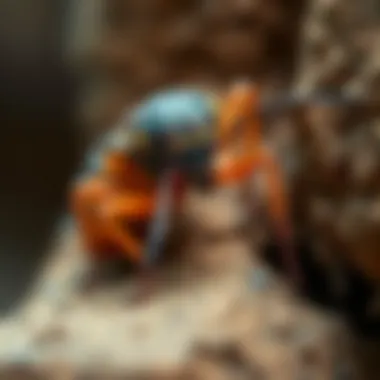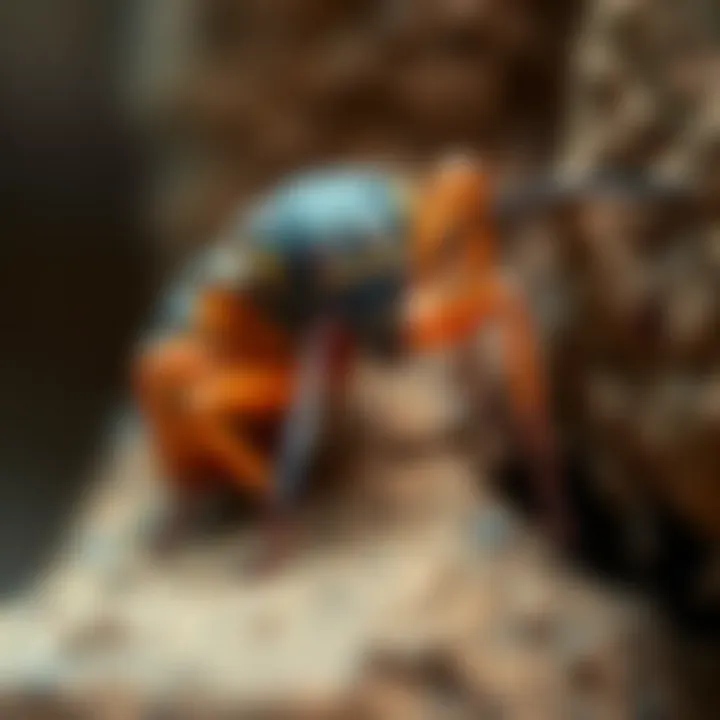Exploring Effective Perx Pest Control Strategies


Intro
In an era where the battle against unwanted guests in our homes—pests—is as critical as ever, understanding the measures for pest control becomes essential. Homeowners, particularly housewives diligently striving to maintain a comfortable and safe living environment, often find themselves at a crossroads when faced with pest issues. Perx pest control emerges as a robust ally in these situations, offering well-rounded strategies tailored to handle a variety of pest-related concerns. This article is designed to unravel the-layered complexities of pest management, paving the way for informed, effective approaches.
Understanding Pests
Definition of Pests
Pests are typically defined as organisms that interfere with human activities, causing damage to crops, homes, and health. Ranging from tiny insects to larger rodents, pests often invade living spaces in search of food, shelter, or reproduction opportunities. Their presence can be a nuisance and lead to serious repercussions, including property damage and health risks. Each type of pest harbors unique traits, and responding to them effectively requires a detailed understanding of their behavior and needs.
Importance of Pest Identification
Recognizing the signs of a pest infestation is a foundational step toward effective pest management. Not all pests are harmful, and some might even contribute positively to our environment. For homeowners, understanding which pests they are dealing with is crucial. Misidentifying a pest can lead to using ineffective or harmful control methods, potentially exacerbating the problem.
Some of the common pests include:
- Ants
- Cockroaches
- Bedbugs
- Rodents
- Termites
It’s imperative to equip oneself with the knowledge surrounding the characteristics of these pests, as this knowledge can guide decision-making for appropriate intervention strategies.
Prevention Techniques
Home and Garden Preventative Measures
The old saying "prevention is better than cure" holds particularly true in pest control. Keeping an eye on conditions that invite pests can truly tip the scales in your favor. Consider the following practical methods:
- Seal Cracks and Crevices: Regularly inspect your home’s foundation, window frames, and doors. Utilize caulking to seal gaps where pests can slip through, ensuring a tighter fortress.
- Maintain Cleanliness: Keeping a tidy environment goes a long way. Regularly vacuum and clean up crumbs from food preparation areas. Ensure garbage is sealed and disposed of regularly.
- Proper Storage: Food items should be stored in airtight containers, which limits access for pests.
Seasonal Prevention Tips
Pest behavior can change with the seasons, and being aware of these shifts can bolster your prevention efforts. In the spring, for instance, homeowners should check for signs of termite activity as these pests become more active in warmer weather. During the fall, it’s wise to inspect for easy entry points into the home as pests seek warmth.
Eco-Friendly Pest Control Solutions
Overview of Sustainable Practices
As environmental concerns grow, eco-friendly pest control solutions are becoming increasingly popular. These practices focus on employing strategies that minimize harm to the ecosystem while effectively managing pest populations. Utilizing integrated pest management techniques allows for a more sustainable approach, often combining biological, cultural, and mechanical practices.
Natural Remedies and Their Effectiveness
For the environmentally conscious, natural pest control remedies present a lucrative alternative to chemical solutions. Typical natural pest deterrents include:
- Diatomaceous Earth: It serves as a natural insecticide, effective against crawling insects. This powder damages the exoskeleton of insects, leading to dehydration.
- Essential Oils: Oils from peppermint, lavender, and tea tree can repel pests. Mixing essential oils with water can create a spray that deters insects around the home.
- Homemade Traps: Simple traps made with ingredients like vinegar can help catch fruit flies or common kitchen invaders.
"Adopting eco-friendly strategies not only helps in controlling pests but also benefits the environment, ensuring a healthier living space."
For those looking to dive deeper into natural pest control methods, resources such as Natural Pest Control provide informative insights.
For additional insights, you might found Reddit helpful in connecting with others who share similar pest control challenges and tips.
Understanding Perx Pest Control
The importance of understanding Perx Pest Control cannot be overstated, especially for those who wish to maintain their homes as safe havens against pesky invaders. Pest control is not just about eliminating unwanted creatures; it’s about creating an environment where these intruders are managed or prevented altogether. By delving into the intricacies of Perx, we gain insights into methodologies that balance effectiveness with ecological considerations.
Benefits of Understanding Perx Pest Control:
- Enhanced Safety: Knowing how to address pests can contribute to the health and safety of your home. Certain pests can present health risks, and being informed equips you to tackle these issues.
- Reduction in Harmful Chemicals: Many pest control strategies emphasize eco-friendly solutions. Understanding these can help you minimize reliance on harsh chemicals that might affect your family or pets.
- Cost-Effectiveness: An informed approach often leads to savings in pest control costs. Whether it's through preventative measures or efficient interventions, knowledge can empower homeowners.
Furthermore, as climates change and urban areas expand, pest populations evolve. Keeping abreast of new strategies and insights is crucial for effective pest management.
What is Perx Pest Control?
Perx Pest Control refers to a specific methodology and set of practices designed to manage pest populations effectively while considering the environmental impact. It blends traditional pest control techniques with modern, sustainable approaches.
Typically, the focus lies not only on eradication but also on prevention. It takes a broader view to understand the ecosystem guests and intruders alike inhabit. Special emphasis is placed on educating homeowners about their environments, revealing the significance of behaviors that attract pests and those that deter them.
In simpler terms, Perx Pest Control is about being a step ahead. Instead of waiting for a problem to arise, the focus shifts to anticipating and managing potential pest-related issues. This holistic understanding aims to foster a harmonious living space where human, animal, and plant life coexists.


History of Pest Control Solutions
The history of pest control solutions spans thousands of years. Early civilizations relied on physical barriers, like nets, to keep pests at bay. Ancient Egyptians even used cats to control rodent populations, demonstrating a reliance on natural predators long before modern methods existed.
As society evolved, so did the strategies for pest management. The 19th century saw the introduction of chemicals specifically designed for pest control. Dichloro-Diphenyl-Trichloroethane, better known as DDT, was a game-changer, albeit later revealed to have significant health and environmental repercussions.
Through the decades, lawmakers and scientists recognized the harms of such substances. The discourse shifted towards Integrated Pest Management (IPM)—a more holistic approach combining various strategies, such as biological control, cultural practices, and chemical solutions only as a last resort.
Interestingly, as new chemicals were developed, so too were regulations to limit their use. Nowadays, the trend is towards environmentally friendly solutions, paralleling what has been learned over the past decades. The understanding of pest control has matured into an awareness of long-term impacts—not only solving immediate problems but ensuring sustainability for future generations.
Methods of Pest Management
The significance of methods of pest management cannot be overstated in today’s world. As homeowners and renters alike navigate the challenges of pest control, understanding the various strategies available helps not only in effectively eradicating unwanted pests but also in ensuring that these interventions are safe for the environment and household members. The importance lies in the balanced approach that combines effectiveness with safety, considering the impact that chemicals can have on human health and the ecosystem. The right methods of pest management can mean the difference between a peaceful home and a sanctuary for pests.
Chemical Pest Control Techniques
Chemical pest control techniques are perhaps the most recognized of pest management strategies. These include the use of pesticides, insecticides, and herbicides, which can swiftly eliminate unwanted biological guests. However, it's crucial to utilize these products judiciously. The benefits of chemical pest control are clear: strength and speed. Products designed for home use, such as Raid or Ortho, provide immediate results, often knocking down infestations in a matter of hours.
Yet, homeowners must proceed with caution. Misapplication or overreliance on chemicals can lead to resistance among pests, making them more difficult to control in the future. Moreover, the potential health risks associated with long-term exposure to these substances must be taken into account. Therefore, it’s advisable to always read labels, wear protective equipment, and consider integrating with other strategies as well to ensure an effective and safe approach to pest control.
Biological Control Agents
Biological control agents refer to natural predators or pathogens used to manage pest populations. This method embraces the age-old practice of using nature's own defenses against pests, showcasing an elegant balance with minimal disruption to the environment. Common biological agents include ladybugs and nematodes, which target specific pests like aphids or grubs. Utilizing biological controls can lead to sustainable pest management practices, minimizing the need for harsh chemicals.
However, one must have appropriate knowledge and patience in implementing biological controls. It is not a quick fix; rather, it requires fostering an ecosystem where these beneficial organisms can thrive and perform their duties effectively. Understanding pest life cycles and the conditions that support biological agents is necessary. Therefore, studying the unique dynamics of your garden or home environment becomes essential for success.
Cultural Control Practices
Cultural control practices focus on altering the growing environment to make it less favorable for pests. This holistic approach includes techniques like crop rotation, sanitation, and the careful selection of plant varieties that are resistant to pest infestations. For instance, rotating crops instead of planting the same family of vegetables in one spot consistently helps disrupt the life cycles of pests that prey on those specific plants.
Cultural practices can also involve simple household strategies, like removing standing water to prevent mosquito breeding or cleaning up food spills to deter ants and roaches. These methods are often low-cost and environmentally friendly, making them accessible to a wide audience. Ultimately, by integrating cultural controls into pest management strategies, households can create a long-term solution that not only minimizes infestations but fosters a healthy living environment.
"Practical knowledge in pest management equips homeowners with the tools they need to combat infestations effectively, ensuring comfort and well-being in their homes."
In summary, understanding different methods of pest management, from chemical techniques to cultural practices, enables homeowners to adopt a flexible and informed approach. Each technique has its strengths and weaknesses, but together they create a comprehensive toolkit for maintaining a pest-free environment. Engaging in these practices can assure homeowners that they are making substantial strides in protecting their living spaces against pesky invaders.
Pest Identification
Pest identification is not just a mundane task; it's akin to putting together the pieces of a puzzle that reveals the state of your living environment. Identifying pests correctly is the first and most crucial step toward effective pest management. Without a clear understanding of what you are dealing with, your efforts may feel like shooting in the dark.
By recognizing specific pests, homeowners can tailor their approaches, ensuring that they employ the most effective treatments suitable for particular invaders. For example, not every insect in your garden is harmful; understanding which ones are just seeking shelter or which are detrimental can save both time and resources. Furthermore, proper pest identification can prevent the unnecessary application of harsh chemicals, which is vital for both personal health and environmental safety.
Common Household Pests
When we speak of common household pests, we often picture those unwelcome guests creeping through our kitchens and hiding away in dark corners. Ants, cockroaches, and rodents are some of the usual suspects.
- Ants: These social insects can invade homes in search of food. They typically form trails, making it easier to track their entry points. Understanding their species can help in determining whether to use bait or repellents.
- Cockroaches: Recognized by their broad, flat bodies, these pests can carry diseases. If identified quickly, controlling a small population may be straightforward, but they multiply quickly, so vigilance is key.
- Rodents: Mice and rats are not just creepy; they’re known vectors for many diseases. Checking for droppings and gnawed materials can help confirm their presence.
Recognizing the traits and behaviors of these pests might not sound all that thrilling, but it’s essential. By doing so, homeowners can pick their battles wisely, investing in remediation methods that truly address the issue at hand.
Identifying Garden Pests
Identifying pests in your garden is an art form, and every master gardener knows it well. Garden pests can wreak havoc on your prized tomatoes and petunias. Familiarizing yourself with the signs of infestation can make all the difference.
- Aphids: Tiny and often green, they flourish on young shoots and greens. Their soft bodies make them easy prey for natural predators.
- Caterpillars: Vividly-colored and hungry, these munchers can decimate leaves overnight. If you notice missing foliage, check beneath the leaves where they often hide.
- Fungal attacks: These might not be pests in the traditional sense but can present themselves in unusual discolorations or powdery mildew. Recognizing these signs helps you take preventive measures before they turn into more significant issues.
Using the right identification leads to targeted decision-making. This targeted approach ensures you keep your garden thriving while reducing frustration.
Using Traps for Identification
Using traps can simplify the pesky business of identifying invaders. Traps are a hands-on way to uncover which pests are traipsing through your home or garden without playing hide and seek.
- Sticky traps: These are particularly useful for capturing flying pests. They’re straightforward; if something sticks to the surface, you’ve got an invader.
- Bait traps: These not only lure pests like cockroaches or rodents but also provide insight into their population sizes and types when you can examine what gets trapped.
- Pheromone traps: Designed to attract specific types of insects based on their scent, these traps can help you identify issues without resorting to harsh chemicals.
"The early bird catches the worm," and in pest control, early identification can save you a boatload of hassle and costs later on.
For more information on pest types and effective identification strategies, you can visit Wikipedia, or check out the introduction to pest management on Britannica for broader insights.


Preventative Measures
Preventative measures are crucial when dealing with pests. They focus on stopping pests before they even get a foot in your door, which can save time, money, and a whole lot of headache. Prevention isn't just an afterthought—it's a proactive approach that essentially lays a solid foundation for maintaining a pest-free home. With the various environmental, biological, and chemical challenges posed by errant insects and critters, it’s imperative to recognize that keeping these unwelcome guests at bay begins long before they signal their unwanted arrival.
By employing preventative techniques, homeowners can significantly reduce the likelihood of pest problems. It’s not only about avoiding infestations, but also about creating a healthier living environment. Pests can carry diseases and allergens, making your home less hospitable. For instance, a well-kept kitchen, free from crumbs and spills, minimizes the chances of attracting ants, cockroaches, and other nasty creatures.
Here are some benefits of strong preventative measures:
- Cost-effective: Tackling pest issues before they escalate means fewer expenses spent on treatments or damages.
- Healthier home: Preventing pests contributes to better air quality and overall health for all residents.
- Peace of mind: Knowing you have done what needs to be done to deter pests brings a sense of security.
DIY Pest Prevention Tips
When it comes to preventing pests, do-it-yourself strategies can be both simple and effective. Homeowners often underestimate how small changes around the house can create a formidable barrier against pests. Here are some handy tips:
- Seal entry points: Check for cracks and gaps in windows, doors, and walls. A little caulk can stop a whole lot of trouble.
- Store food properly: Always keep food in airtight containers and regularly clean pantry areas. This can thwart pesky pantry moths and weevils.
- Maintain cleanliness: Regular sweeping, vacuuming, and mopping won't just keep your floors looking good; they'll also remove potential food sources for pests.
- Use natural deterrents: Bay leaves in cupboard or a few drops of peppermint oil can act as natural repellents. Sometimes, nature knows best!
- Monitor moisture levels: Pests love damp spots, so fix any leaky faucets or plumbing to prevent attracting unwanted visitors.
Environmental Considerations
Understanding the environmental impact of pest control methods is becoming increasingly important for many homeowners. As more people become conscious of their ecological footprint, they are turning to pest control solutions that not only safeguard their homes but also protect the environment. This shift is pivotal, especially considering the potential harm that widespread chemical use can inflict on ecosystems.
Some points to ponder include:
- Biodiversity: Chemical treatments can negatively affect beneficial insects like bees and ladybugs, which play a vital role in the ecosystem. Choosing eco-friendly methods helps maintain this delicate balance.
- Water Quality: Pesticides can run off into local waterways, harming aquatic life and contaminating water supplies. Homeowners should consider solutions that reduce such risks.
- Chemical Residue: Using strong chemicals can leave residues that linger in the home environment, which could pose health risks to family members, especially children and pets.
By integrating environmentally-friendly practices into pest control strategies, one can manage pests effectively while showing respect for nature. Taking all these considerations into account not only benefits individual households but also contributes to the greater good.
"An ounce of prevention is worth a pound of cure." This timeless saying underscores the importance of implementing these measures before problems arise, ensuring not just a pest-free home but also a more sustainable one.
Eco-Friendly Pest Control Options
In today's world, more folks are leaning towards eco-friendly solutions for many aspects of their daily lives, and pest control isn't any different. Eco-friendly pest control options not only minimize the negative impact on the environment but also assure safety for human health and pets. Using natural remedies and sustainable practices is becoming more popular, as people realize that chemical pesticides often come with adverse effects, like harming beneficial insects or contaminating water supplies. These eco-friendly methods embrace nature's way of maintaining balance in ecosystems and protect our homes at the same time.
Natural Repellents and Remedies
Utilizing natural repellents is like having your cake and eating it too—they keep pests at bay without the harmful chemicals. Many everyday ingredients can be found right in your kitchen or garden, making them easily accessible. Here are some of the more effective ones:
- Essential Oils: Oils like peppermint, tea tree, and lavender act as powerful deterrents. A few drops mixed with water in a spray bottle can create a natural repellent.
- Vinegar: White vinegar can repel ants and spiders. Spraying a mix of vinegar and water around entry points is a simple yet effective tactic.
- Citrus Peels: Citrus is not just refreshing for humans; pests dislike the scent. Laying out peels in areas where insects are a problem can reduce their presence.
- Garlic Spray: Known for its powerful smell, garlic makes a decent repellent when mixed with water and sprayed around the home.
Using these remedies not only addressed pest problems but also shows a commitment to sustainability, using what nature provided us rather than manufacturer-produced chemicals.
Sustainable Practices in Pest Management
Sustainable practices in pest management are essential for long-term success. Addressing the root causes of pest issues is more effective than merely treating symptoms. Here are some sustainable practices worth considering:
- Crop Rotation: For those with gardens, rotating crops is a proven strategy to minimize pests. Different plants attract various pests, so changing the crops can disrupt their life cycles.
- Beneficial Insects: Intensifying the presence of beneficial bugs, like ladybugs and lacewings, can help keep problematic insects in check. They prey on insects like aphids without affecting the environment adversely.
- Companion Planting: This technique involves planting different species close together. Certain plants can deter pests when grown alongside others. For example, marigolds can repel nematodes while boosting the health of nearby crops.
- Use of Barriers: Physical barriers like row covers or netting can prevent pests from reaching vulnerable plants without any chemical intervention.
Adopting these sustainable strategies requires a bit of groundwork but pays off in the long run by producing healthier plants and a more natural environment. It encourages us to rethink traditional pest management and embrace long-standing methods that support the planet.
"Building a sustainable ecosystem starts with us. Small changes in practices can lead to bigger impacts on the environment."
The Role of Technology in Pest Control
In an ever-evolving landscape, the intersection of technology and pest control has emerged as a game-changer. Homeowners and pest control professionals alike stand to gain profound insights from integrating innovative technologies into pest management strategies. The contemporary challenges posed by pests require tools that not only excel in efficacy but also prioritize safety and environmental considerations. More than just a mere convenience, technology in pest control embodies a potential revolution that can streamline processes, enhance effectiveness, and promote a healthier home environment.
Innovations in Pest Control Technology
The modern age has gifted us what seems to be a cornucopia of advancements aimed at pest control. From drones that scout for infestations to climate-controlled traps that lure pests in without the use of harmful chemicals, the innovations are numerous and varied. For instance:
- Drones and Monitoring Devices: Drones are not merely for aerial photography. These equipped machines can assist in detecting pest hotspots remotely, saving time and manpower. By surveying large properties swiftly, they provide valuable data on pest distribution.
- AI and Machine Learning: Artificial intelligence systems analyze vast amounts of data from past pest behavior to predict future infestations. This analytics-based approach allows homeowners to act preemptively.
- Electronic Monitoring: Devices equipped with IoT (Internet of Things) technology keep real-time tabs on pest activity. Instead of waiting for signs of an infestation, homeowners are alerted to problems as they arise.
These technologies not only increase efficiency but also ensure that pest controls can be applied in a much more targeted manner. This level of precision reduces the need for widespread chemical applications, thereby lessening the impact on the environment.
Smart Pest Management Solutions
Smart pest management solutions offer a comprehensive approach that incorporates technology into daily pest control practices. These systems are not a one-size-fits-all but rather customizable strategies tailored for specific environments and pest types. Here are a few notable elements of smart pest management:
- Data Collection and Analysis: Using sensors, homeowners can monitor humidity and temperature—factors that are attractive to pests. Collecting this data guides informed decisions on when and how to act against potential threats.
- Automated Pest Control: Systems that use sound, light, or even vibrations to deter or trap pests autonomously. These solutions minimize human intervention while maintaining effectiveness.
- Integration with Home Systems: Smart pest management solutions can be integrated into existing home automation systems, allowing for seamless control through smartphones or other devices.


Smart pest control is like having a personal assistant who knows exactly when to act, ensuring your space remains pest-free without you lifting a finger.
Not only does this save time for homeowners, but it also reduces stress. Pest management becomes a proactive strategy rather than a reactive problem. Through these smart solutions, pest control enters a new era, where technology not only assists users but ultimately reshapes the entire concept of pest management.
By embracing these technologies, homeowners enhance not only their ability to combat pests but also contribute positively towards sustainable practices that protect the environment.
For further reading on the convergence of technology and pest control, you might find the following resources helpful: Wikipedia on Pest Control, Britannica on Insect Ecology.
Addressing Common Pest Myths
Understanding and addressing pest myths is crucial in the realm of pest control. These misconceptions not only cloud homeowners' judgment but can also lead to ineffective treatments and unnecessary panic. Importantly, acceptance of myths can even foster environments where pests thrive, as preventative measures are neglected or misapplied. To break the cycle of misinformation, it’s key to differentiate fact from fiction. This understanding allows us to adopt more effective and scientific approaches to pest management, ensuring a healthier living space.
Debunking Popular Misconceptions
There are many commonly held beliefs about pests that simply don’t hold water. For instance, one prevalent myth is that all insects are harmful. The reality is, many insects play beneficial roles, such as pollinators or as natural predators to harmful pests. This essential truth underscores the importance of understanding pest dynamics rather than instantaneously reaching for chemical solutions.
Another misconception is that a clean home guarantees pest-free living. While cleanliness does help, pests can still intrude from outside or via packages. It’s important to recognize that even the tidiest homes can face pest challenges. Addressing potential entry points and implementing sound preventative practices is more effective than simply relying on hygiene alone.
A popular saying goes, “A bird in the hand is worth two in the bush.” This highlights the importance of caution; trying to eliminate one pest type can sometimes lead to the unintended consequence of attracting others. Many extermination methods create a vacuum effect that allows new pests to move right in. Regular monitoring and proactive preventative measures can be more effective in maintaining equilibrium within the ecosystem of your home.
The Truth About Insect Ecology
Insect ecology is far more intricate than many believe. Understanding the roles that various pests play in nature can enlighten homeowners about the broader implications of their pest control strategies. For example, ladybugs feast on aphids, and their presence can significantly reduce aphid populations without the need for pesticides. Embracing this ecological perspective not only aids in the safe removal of pests but also promotes a balanced environment in your garden.
Furthermore, myths often misrepresent the life cycles of pests. Many people think that once they see a cockroach, their problems are insurmountable. However, knowing that many pests reproduce quickly can lead to timely interventions before an infestation spirals out of control. Recognizing that early detection and understanding pest behavior are vital steps in effective pest management can help mitigate larger issues.
"Knowledge is power - and in pest control, it could make all the difference."
For more information on pest ecology, you can visit resources like USDA.gov, which dives into the roles of different species in their environments. The National Pest Management Association also offers valuable insights into effective pest control strategies on PestWorld.org.
Case Studies in Pest Management
Case studies in pest management are essential to really understand how different strategies play out in real-world situations. They serve as a bridge between theory and practice, bringing alive the tactics and tools that pest control professionals use. By analyzing cases where pest control has succeeded and where it has faced challenges, homeowners can glean valuable insights that help in making informed decisions. This section emphasizes experiential learning, showcasing both the triumphs and the missteps in pest management.
Successful Strategies Implemented
In the journey of pest control, success stories often shine like beacons, illuminating paths others might take. For instance, a community in a certain Midwestern town successfully revamped its approach to managing a persistent cockroach issue. They began by surveying the area, identifying where roaches thrived. Their strategy included a combination of proper sanitation practices, sealing entry points, and targeted baiting techniques with low-residue pesticides.
- They maintained strong communication channels with residents, encouraging them to report any sightings.
- Bait stations were installed strategically around the community, and follow-ups ensured their effectiveness.
- Regular educational sessions were held to inform residents about how to minimize attractants in their homes.
This approach led to a significant decrease in roach sightings within just a few months. Not only did they tackle the immediate problem, but they also fostered a sense of community involvement and awareness. Such case studies encourage homeowners to adopt proactive stances rather than merely reactive ones.
Lessons Learned from Failures
Learning from mistakes is just as crucial as celebrating successes. One notable case involved a suburban setting where pest control efforts to combat rodents fell flat. Homeowners relied solely on trapping methods, disregarding underlying issues with waste management. Here’s what went wrong:
- Traps were set up, but without addressing the rodent's food sources and nests, these efforts were like pouring water into a sieve.
- The lack of a comprehensive plan meant they never tackled the root of the problem, leading to a re-infestation shortly after initial trapping.
- Communication was lacking, with homeowners acting individually rather than as a united front.
From this experience, the understanding emerged that integrated pest management requires a holistic view. Addressing the environment, educating residents, and collaborating as a community are keys to a long-lasting solution. These lessons highlight that if homeowners do not look at the bigger picture, they risk becoming stuck in a cycle of temporary fixes.
By delving into case studies, individuals can better appreciate the wins and losses that shape pest control, ultimately leading to smarter, more effective practices in their own homes.
Future Trends in Pest Control
As we look ahead in the field of pest management, understanding the emerging trends is going to be crucial for both homeowners and professionals. The future of pest control, especially through the lens of Perx, aims to emphasize not only effectiveness but also sustainability and technological advancements. These trends are relevant as they reshape how we tackle pest issues in our homes, gardens, and beyond.
Emerging Research and Developments
Research plays a significant role in molding the future landscape of pest control. New findings are continuously shedding light on the behaviors and patterns of pests, which in turn informs better management methods.
- Genetic Research: One notable area of focus is genetic modification. Scientists are exploring ways to alter insect genes to make them less viable or less harmful. The implications of this could be profound—not just in ecological terms but also in how we view pest control in general.
- Biorational Products: Development of biorational products is on the rise. These are derived from natural materials or processes, offering a sustainable alternative to synthetic chemicals. Homeowners swinging towards this green revolution are asked to keep an eye on products stemming from plants or even fungi that disrupt pest life cycles.
- Digital Monitoring Systems: With a shift towards smart homes, introducing automated pest monitoring systems can effectively lower infestations. Sensors placed in strategic areas can alert owners of any pest activity, allowing for timely interventions before a full-blown problem emerges.
Such research developments are not just scientific jargon; they represent actionable strategies homeowners can adopt.
The Impact of Climate Change on Pest Management
Climate change is altering ecosystems and, consequently, pest populations. Warmer temperatures, erratic weather patterns, and altered rainfalls are creating more favorable conditions for pests, expanding their range and increasing their breeding cycles.
- Increased Pest Activity: Warmer winters mean that pests like cockroaches or ticks can thrive longer, often leading to an extended pest season. Therefore, it’s essential for homeowners to remain vigilant, as anticipated pest activity can vary from year to year depending on climatic changes.
- Shifts in Pest Populations: As the climate warms, some pests are migrating to areas previously considered inhospitable. Areas where pests were once few and far between may experience sudden surges in infestations, creating new challenges for local pest management strategies.
- Adapting Control Strategies: It’s imperative that pest management strategies adapt to these shifts. For instance, understanding new pest pressures might require an integration of diverse control measures, such as mixed crop cultivation or intercropping, thereby enhancing natural pest resistance.
"The changing climate will not just impact weather patterns, but it will also dictate the pest dynamics we face in our homes and gardens. Embracing adaptability is the key to effective pest management in the future."
A proactive approach is essential, as adapting to climate change will not be a one-time effort but rather an ongoing commitment for households aiming to maintain a pest-free environment.



